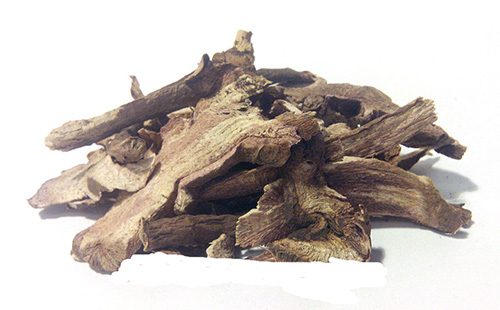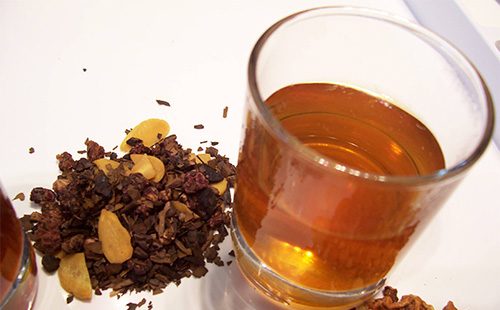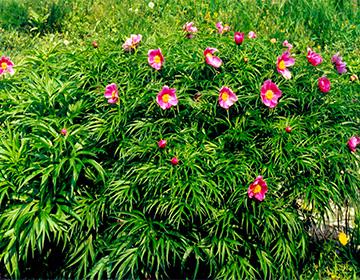The content of the article
Peony evader is protected by the Red Book of several countries. The reasons for this are the difficulties with the restoration of the range with frequent harvesting and the high value of individuals growing in the wild. An endangered culture is found on the fringes and glades of mixed, pine and small-leaved forests. It is choosy to the quality of the soil - it requires its saturation with nutrients. Thickets a plant forms only occasionally. It is actively cultivated for the pharmaceutical industry. Sometimes found in mountain meadows among tall grasses.
Botanical characteristic
Maryin root belongs to the Pionov family. It is a perennial grass reaching a height of about 1 m. Outwardly, it is a bit similar to fine-leaved peony: both plants have a simple flower consisting of five petals. However, the remaining parts are different, not allowing you to confuse the healing look with its relative. Morphological characteristics are as follows.
- Underground part. Well developed. It is represented by a many-headed rhizome, from which the accessory roots of the spindle-shaped form penetrate deep into the soil. They are fleshy, juicy, with a dense core and a characteristic odor.
- The stalks. One rhizome has several branches. Ribbed, cylindrical, leafy in the upper part. The base of each stem is covered with leathery scales. They are peduncles.
- Leaves. Twenty-three dissected, change color three times in a year. In the spring they are painted in crimson shades, in the summer - become emerald, and in the fall - orange-red or crimson again. The leaves are large, wide, longer than the petioles. As a rule, they reach a length of 30 cm. They may be slightly rough due to pubescence or bare.
- Flowers. Purple-pink color, have a double perianth. The diameter of peony flowers can reach 18 cm, which is why the plant is of great decorative value. Deliver a pleasant aroma. The crop blooms in May or June. In mountainous areas, flowering lasts longer.
- Fruit. Presented with leaflets with seeds inside. They are shiny, black in color, have an elliptical shape. Ripen from July to August.
Harvesting raw materials
Medicinal properties are present in all parts of the plant, however, the highest concentrations of nutrients are found in the underground. Harvest the flower completely during flowering. To preserve the population, a cut of grass with part of the rhizome directly in the ground is required. Of the remaining underground organs, the plant is restored over time.
Dried grass and rhizomes separately. In vivo or using dryers. In the second case, a temperature of 50 ° C to 60 ° C is required. The root is pre-washed and cut into pieces. Drying the grass requires observation and regular turning of the raw material, otherwise it rots.
Composition
The final composition of the plant has not been studied to this day, however, the main pharmacologically active substances have been established.
- Essential oil. Provides a characteristic smell of plant stocks. It has antibacterial properties, as well as sedatives. Enhances motility of the stomach and intestines. Stimulates the secretion of glands, stops putrefactive and fermentation processes in the intestine.
- Glycoside compounds. The most important is salicin. Substances of this group give a sedative effect, dilate blood vessels and eliminate smooth muscle spasms. Under their action, urine formation is enhanced. And also the secretory activity of the bronchial epithelium is normalized, which facilitates the discharge of sputum.
- Tannins. The key is tannin. It has astringent and anti-inflammatory activity, neutralizes pathogenic microorganisms. On the damaged areas of the epithelial tissue creates an albuminous film, which determines the regenerative properties of the plant. Also, tannins envelop the gastric mucosa and inhibit the activity of cells with excessive secretion of hydrochloric acid.
- Flavonoids. They act as antioxidants with antitumor activity. They have antimicrobial properties. Normalize the strength of the vascular walls. Enhance the formation of bile. Provide anti-allergic effect and remove toxins from the body.
- Alkaloids. They have the ability to suppress the processes of excitation in the brain, showing a sedative effect. Eliminate pain, have muscle relaxant properties. Able to reduce pressure, stop bleeding, including internal.
- Organic acids. Beneficial effect on the condition of articular and bone tissue. Improve metabolic processes. Normalize the acidity of the media. They exhibit antioxidant and anti-inflammatory properties.
- Fatty oil. Regulates the hormonal background, lowers cholesterol, promotes hematopoiesis, normalizes the biochemical composition of blood and strengthens the immune system.
- Minerals Necessary for the normal functioning of muscles, brain, endocrine glands. The plant contains chromium, sulfur, strontium, cobalt, copper, potassium, aluminum, and iron.
The anti-inflammatory and antibacterial properties of the peony root are due to the content of salicylic, acetylsalicylic and benzoic acids. These substances give the plant anti-febrile activity, local antimicrobial action and the ability to eliminate various skin lesions - from autoimmune to infectious.
Healing properties
Maryin root is called a plant for its ability to help women in a variety of issues. In the absence of developed medicine, the grass was used for infertility, to preserve the husband's sexual viability, get rid of bad habits and prolong youth. This versatility is due to the many pharmacological effects of the plant:
- anti-inflammatory;
- sedative;
- anesthetic;
- expectorant;
- antibacterial;
- antitumor;
- regenerating;
- cleaning;
- tonic;
- immunostimulating.
Nervous system
In ancient times, peony tincture replaced modern psychotropic, antipsychotic, anxiolytic and anticonvulsants. That is why it was said that the plant "drives out the darkness." Today, the remedy is treated:
- hysteria;
- obsessive fears;
- anxiety;
- neurosis;
- insomnia.
An effective phytopreparation even in the complex treatment of epilepsy and cerebral palsy. Grass noticeably weakens the symptoms of these ailments.
The use of peony is appropriate for chronic fatigue, apathy, and depression. The plant normalizes the excitability of nerve structures.First, a sedative effect occurs, allowing you to eliminate anxiety and internal stress, and after it - tonic. The flower improves mood and stamina, promotes positive thinking.
The anticonvulsant properties of the culture are also known. It relieves tension not only of striated muscle tissue, but also smooth. Thus eliminates migraines and neurogenic headaches.
Leather
For external use, the drug treats ulcers, abscesses, internal suppuration, infected wounds, pressure sores, trophic ulcers, burns, frostbite. It is appropriate to prescribe phyto-raw materials for injuries without violating the integrity of the integument - tumors, bruises, bruises, swelling of the joints, bone pain, gout. In the latter case, the internal intake of the plant is combined with external treatments.
It also fights effectively against difficult diseases like psoriasis and eczema. The plant reduces itching, eliminates urticaria. Helps to get rid of a rash of neurogenic origin.
Gastrointestinal tract
Culture can stimulate peristalsis of the stomach and increase the acidity of its juice. This allows the plant to be used in the treatment of hypoacid gastritis. Also, the drug eliminates diarrhea of infectious and toxic origin. Previously, marin root was the first treatment for any poisoning.
The plant has a positive effect on the functioning of the intestine - it normalizes the microflora, eliminates bloating, fermentation processes. It can be used to stimulate appetite.
Bad habits
Since ancient times, it is known about the role of plants in the treatment of alcoholism. The tool is used independently or introduced into the composition of the fees. The success of therapy depends on the patient's desire, and a peony helps to form it. It reduces cravings for alcohol, forms an aversion to hard liquors.
The sedative properties of the plant are also relevant here: it makes alcoholics more relaxed. It also alleviates the condition of a hangover.
Lungs
The tool eliminates coughing fits, normalizes sputum formation and stimulates its elimination. It also prevents bronchitis and pneumonia.
Often, peony is combined with other herbs in the composition of breast collections. Perfectly complement its action - coltsfoot, licorice, violet, thyme.
Women Health
For women, preparations from the plant are prescribed in the following situations.
- Infertility. The flower is recommended for hormonal and neurogenic infertility. The tool helps to normalize the level of estrogen necessary for successful ovulation, prevents repeated hormonal disorders. In addition, it is able to eliminate adhesions and puffiness.
- Diseases of the mammary glands. Helps with mastopathy. Used externally in combination with licorice, and also taken orally for a complex effect.
- Cycle changes. The flower is used to lower testosterone and increase female hormones. This contributes to the normalization of the cycle and reproductive function. The tool relieves the symptoms of PMS and prevents the onset of early menopause. In menopause, it normalizes the psychoemotional state, minimizes “hot flashes” and sweating.
- Other gynecological pathologies. Inflammation of the uterus and ovaries, cystic formations, polyps, myoma, endometriosis - with all the aforementioned ailments, a phytopreparation can be included in the treatment complex. This is due to the fact that the plant affects hormones, acts as a bactericidal agent, fights inflammation and swelling, and also has an oncoprotective effect.

Man's health
Peony can be used to treat and prevent impotence. In particular, if it has a psychogenic origin. The medication stimulates the production of hormones, has an anti-inflammatory effect, improves blood circulation.
But due to the sedative effect and the ability to regulate the testosterone background, it can also be used as an antagonist of sexual elevation. A man will become more calm and balanced, his sleep will normalize.
Prescription Drugs
Tincture, the most popular and effective remedy from the plant, is sold in pharmacies. There is also an extract in tablets. But if you want, you can prepare medicines based on the root at home. The course of taking internal funds is 30 days.
Infusion
Features It is used for the treatment of alcoholism, since alcohol extracts are inadmissible in this case. Helps in the treatment of stomach diseases, elimination of menopause symptoms, potency disorders. Promotes rapid relief from coughing.
Preparation and use
- A teaspoon of chopped roots and herbs is poured with three glasses of boiling water.
- Stand the product in a thermos for half an hour.
- After filtering and cooling completely, they are stored in the refrigerator.
- Take three to four times a day for a tablespoon.
Cosmetic concentrate
Features A concentrated aqueous extract can be used only externally - to treat wounds and skin lesions, to eliminate acne, and also to strengthen hair.
Preparation and use
- A tablespoon of raw materials is poured into a glass of boiling water.
- They stand in a thermos for an hour, occasionally shaking.
- The resulting product is filtered, stored no more than a day.
- Used for lotions for wounds, compresses for eczema and psoriasis. With acne, the skin is treated several times a day. Rubbed into the roots of the hair after washing the head.
Tincture
Features Homemade alcohol tincture is used in the same way as a pharmacy. In addition, it is taken for gynecological bleeding, gout, rheumatism, arthritis, migraine and cataracts.
Preparation and use
- 10 g of roots and herbs are placed in a jar and filled with 100 ml of vodka or diluted alcohol.
- Insist in a dark place at room temperature for two weeks. Shake regularly during the aging process.
- Filter, store in the refrigerator.
- Use three times a day for 20 drops.
Ointment
Features The tool is used for joint (including rheumatic and gouty) pain, for neuralgia of various localization, as well as for inflammation of the sciatic and trigeminal nerves.
Preparation and use
- Equal amounts of pork interior fat and grated peonies (dried) are mixed on a fine grater.
- The resulting substance is heated in a water bath, languished after achieving uniformity for another half hour.
- The cooled agent is used topically - they rub on painful places, put under a bandage.
Contraindications phyto-raw materials: children's age, pregnancy, lactation and individual sensitivity to the plant. It is important to comply with the dosage, and in the presence of chronic diseases or malignant tumors, the possibility of therapy should be agreed with your doctor.

Reviews
I accept tincture of peony evading alcohol .... Everything is written in the instructions .. soothes, improves sleep ... drink for a long time with interruptions ... An incomprehensible anxiety goes away .... And the prevention of mastopathy .. According to the doctor, hysterics suffer from mastopathy ... All health and more joyful minutes ... and pleasant communication !!!
Gorshkova, http://forumjizni.ru/archive/index.php/t-9671.html
I went too far, mixing it with tincture of valerian, vomiting began, spent the whole day in bed, my head hurt a lot .. drink it carefully, according to the instructions.
Alexandra, https://www.medsovet.info/herb/11580
Personally, my pressure began to drop very much against the background of taking this tincture (((Therefore, I drank it once a day at night. It should be noted that with this method my sleep improved and I became calmer.
Important! Peony tincture has a slight irritating effect on the gastrointestinal mucosa. Therefore, for those who have stomach problems, this drug should be taken with caution.
AnnGell http://otzovik.com/review_1622085.html

